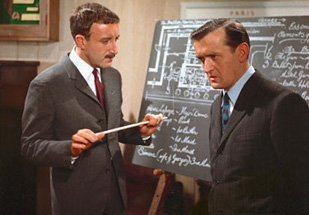Chapter Two: A Shot in the Dark
By Brett Beach
September 23, 2009
It can even be said that Clouseau is almost (is it possible?) suave at certain moments. His character never lacked for lovely ladies over the years either, being paired with Elke Sommers, Lesley Anne Down and Dyan Cannon, among others. Two ironic notes about casting must be inserted at this point. First, Peter Ustinov was the original choice for Clouseau but dropped out mere days before filming began and was replaced by Sellers. This also proved to be the second time in as many years that Niven was to be denied a franchise. He was among author Ian Fleming's top choices to play James Bond in Dr. No (along with Roger Moore, who would, oddly enough, show up in a bit part 20 years later in Curse of the Pink Panther.)
It was never Edwards' intention to continue as director, either. He had moved on to an adaptation of the stage play A Shot in the Dark, a frothy comic murder mystery, which had been a hit on Broadway in 1961 and which itself had been adapted from a French play, The Idiot. His partner in crime on the screenplay was William Peter Blatty, who would go on to infamy penning The Exorcist. Facing the request from the studio for a new feature with Clouseau, A Shot in the Dark became the unlikely jerry-rigged follow up. The bare outlines of the play were kept while Clouseau and many new characters were introduced. Central among these is Chief Inspector Charles Dreyfus. He is Clouseau's superior and it would be accurate to liken their relationship to that of The Road Runner/Wile E. Coyote or Tom and Jerry. Dreyfus begins each installment impeccably dressed, self-assured and calm and winds up being driven by Clouseau to bodily harm, murder attempts and at one point, global incineration. Herbert Lom is sublimely inspired in his portrayal of Dreyfus, with his tic-ing eye or outbreaks of nervous giggles and the best moments of the series are where he is allowed to interact with Clouseau and express his open hostility and animosity, and then suffer the consequences (office burning down, let's say) for simply having the misfortune to know Clouseau. Clouseau's indestructible nature, even as he brings unintentional death and destruction to everything around him, is the greatest sustained joke of The Pink Panther films and the gags built around this are the hallmark of the series.
As a writer and director, Edwards remains an enigma to me, particularly in regards to the lurching whiplash-inducing tonal shifts within his features. Many of his films feature sight gags and moments akin to those in The Pink Panther series, no matter what the subject matter or context of the film and many also seem to waver uncomfortably or unconvincingly between dark cynicism and mawkish sentimentality. Case in point is his bitter satire on Hollywood filmmaking, S.O.B (from 1981). The film can be viewed as an ungodly mashup of Network and Contempt with the rough emotions of late-period Cassavetes. S.O.B. starts out cynically funny and with a plethora of bad taste pratfalls before switching to a straight-faced earnestness in the second half, a shift preceded by an out-of-nowhere comic car chase along the Los Angeles Freeway. I remember catching this on CBS when I was five or six (which of course negated the cynical reason to see the film, which was openly touted in the trailer: Julie Andrews, Edwards' real-life wife, bares her breasts for the first time on camera) and not being bothered by how all over the map things were. In fact, the film struck me as a cartoon more than anything, a feeling amplified by watching it again last weekend and realizing most of the film had been committed to my memory after one viewing 25 years ago!
Continued:
1
2
3
4
|
|
|
|




